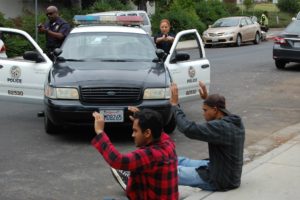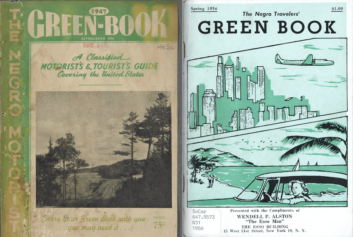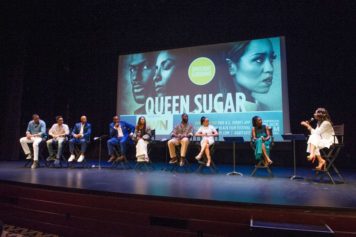“Funny” isn’t the first word people associate with racial profiling, yet writer and actor Dominique Purdy and British director Paul Sapiano have humorously captured the absurdity of it and turned it into a dark comedy aptly titled, Driving While Black.
The film follows a young, Black pizza delivery man named Dimitri and the challenges he faces as he tries to make it to a job interview in Los Angeles.
Driving While Black explores police terrorism in the United States and the extra layer of obstacles that Black men have to overcome in their daily lives. Through flashbacks to Dimitri’s previous experiences with police—even in childhood—the indie film delves into the reasons why minorities often have such a mistrust of law enforcement.
Despite the serious subject matter, the filmmakers felt it lent itself quite naturally to comedy, though they hadn’t seen any comedies about it.
“When me and my friends talk about [police harassment] it’s like we’re so used to it that it’s funny, so that’s where the dark humor comes in,” Purdy says. “Because, it’s a serious thing but there’s funny stuff that happens with dealing with that—[it becomes] kind of an inside joke. It’s almost like we’re letting you in on the psychology of the joke that all types of people have been laughing at without really knowing what it is.”
Comedy also seemed the perfect vehicle to communicate an otherwise uncomfortable topic involving racism.
“The comedy is a way to bring you off guard, almost, to really see how serious this is—and you laugh,” Purdy explains. “Nobody who’s a white person wants to go see a movie [with] a bunch of [violin] strings and sad black people getting beat up. No one wants to see that, so the way to bring other people into it, that don’t understand how serious it is, is put some comedy into it—show that for us this is kind of humorous in an inside joke kind of way, but look how f***ed up this is.”
If it sounds like the content of the film is close to Purdy’s heart, it is. Driving While Black isn’t just a collection of occurrences created for entertainment. It’s based on Purdy’s personal experiences. Appropriately, he also plays the lead character in the film. Purdy and his friend Sapiano decided to do a comedy after sitting around discussing Purdy’s run-ins with the police. Purdy had previously acted in two of Sapiano’s films, including the award-winning indie flick, The Boys and Girls Guide to Getting Down.
The director noted how much of an eye-opener working on DWB was for him. A few rides with Purdy confirmed for him what had only been a distant reality—that Black drivers get tailed more often than white.
“To be quite honest, I’m surprised it wasn’t spoken about more, knowing what I know now about it, but I think as a white guy it doesn’t occur to you that it’s going on, so it’s not something you think is so prevalent,” says Sapiano, who has lived in the U.S. for 15 years. “However, having done some research and to be in the thick of it, I’ve come to quite a different conclusion.”
His conclusion was further supported by 50 other men of color the pair invited to an after-hours bar for a kind of town hall meeting about their experiences with police—men Sapiano says “uniformly had the same story about unwarranted police harassment, every single one of them—all different walks of life.”
The filmmaking process resulted in an awareness for the director of the way police interactions affected the psychology of these men, which in turn, informed their further interactions with police. The psychological effects linger, like the time Purdy recalls being apprehended for “matching the description” of a robber and then turned loose as if nothing had happened.
“[The perpetrator] is not you, and then they just let you go. That was always like a joke I would tell my boys. ‘Damn, man, give me some ice cream or something. You took time emotionally and physically out of my life. I’m not gonna be able to forget this shit. It’s stuck,’” the actor says.
Purdy says that even the presence of police creates an uneasiness that causes a shift in his normal behavior to avoid drawing unwarranted suspicion.
“When I’m on the street, if I see a cop even a far distance driving behind me, I’m aware that he’s there, and I’m like ‘Ok, let me make sure I’m driving 35 now. Let me make sure that I turn this music down ‘cause I was feeling it, but now I can’t dance like I was 5 minutes ago.” He later added, “It’s not comfortable driving there now. I try to look comfortable, so I look like I ain’t doing sh-t, but why do I got to feel like that?”
The affectations he describes are portrayed in DWB where Dimitri and his friends avoid eye contact with officers, suddenly stifle their laughter, and even pretend to be reading a novel when alongside a police vehicle.

Actors on set of Driving While Black
Contrary to what the title suggests, the movie isn’t solely focused on the Black experience. Sapiano and Purdy have strived to make the film accessible to all races.
“‘Driving While Black’ is just an umbrella, as I say to people. Yeah, we actually are the ones experiencing it the most over history, but every race really gets harassed—Hispanic, Asian, even Indian. So, it’s just basically saying, ‘hey man, there’s people out there that are choosing to be prejudice against you just because of the way you look,'” Purdy explained.
This is one of the areas where Driving While Black succeeds the most—in the universality of its story that transcends its title. The film is anything but black and white in any sense of the phrase. Dimitri’s story is reflected in an Indian character and even in a Filipino female cop. The latter is one of the many examples of police presented in the film. DWB aims to present a balanced view of police— not just the negative aspects and not just those who are white. As Purdy explained, “There are Black cops that are mean to you because of their having a certain perception, too—because they’re a ‘higher-up there’ Black guy… and there’s white guys who are like ‘I’m just doing my job.’”
Beyond the issue of race, Driving While Black is about the abuse of authority by officers of the law. Even white Americans can relate to being victims of that abuse, having nothing to do with race, but simply because the officer held a badge. The movie presents multiple sides of a complicated issue.
DWB isn’t heavy-handed or preachy. It’s realistic. Adding to the realism is the use of Purdy’s real-life friends as characters in the film, real gangsters, as well as some real-life police officers who appeared in the movie and acted as technical advisers on set.
The authenticity of the characters and emotions in the film create a relatability that is personified in Dimitri, who is generally a good guy with a few bad habits, not unlike Trayvon Martin or Mike Brown. Therein lies DWB‘s crowning achievement—its relevance—or better still, its continued relevance. Purdy and Sapiano have captured the heightened frustrations of the Black experience with law enforcement in the last two years without ever intending to comment on current events.
They began the script in 2012 before the George Zimmerman verdict that sparked outrage across the nation in 2013 and completed production in July 2014, prior to the Mike Brown shooting.
“When people would tell me like ‘man there’s so much stuff happening right now. Your movie is so relevant.’ I’m like, ‘you know what, if none of that stuff happened and we put the movie out, the sh-t would still be relevant,” asserted Purdy.
Driving While Black was born out of a personal narrative that also happens to be shared among Black men and women across history, making it a timely film simply by virtue of its existence. The comedy may get laughs but the film hits some very intense dramatic notes that hammer home its relevance and force viewers to confront an uncomfortable reality.
Evidence of that relevance was present at a San Francisco screening when a girl remained in her seat five minutes after the film was over. Director Sapiano described the moment saying, “She’s still sitting in her chair, and I go ‘are you ok?’ and she goes ‘yeah I’m just shaken—that film. You know, it’s crazy, I got a younger brother who goes through that.’”
Ultimately, the filmmakers hope Driving While Black will create awareness not only for young Black men to comport themselves with more reserve in police confrontations but for society at-large to understand the tragedy of such racially motivated confrontations in the first place.
“I want people to be aware. Be aware and say you’re not cool with this,” Purdy said. “I hope people get enlightened. I hope more people have conversations about this, and not in a negative way—in a way that’s progressive to the situations that are going on in the world.”
Driving While Black will continue to make its way through the film festival circuit around the country. Producers of the film are also looking into distribution to secure a theatrical release.
The film is currently available for $3.99 on the official website drivingwhileblackmovie.com.
Keep up-to-date with DWB on its Facebook page here.





